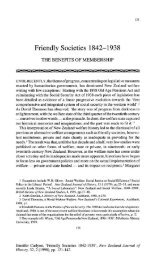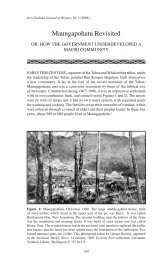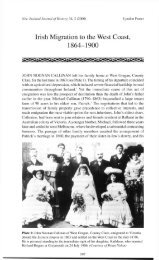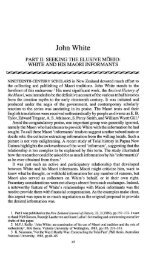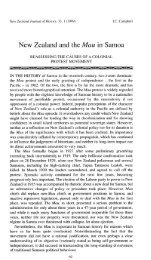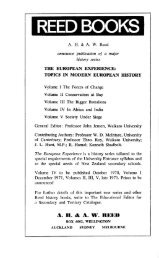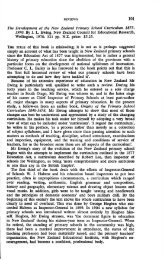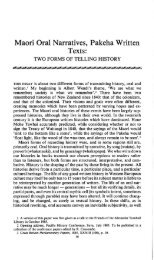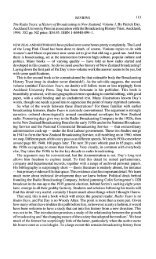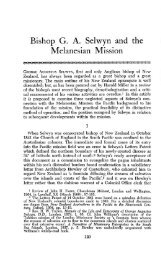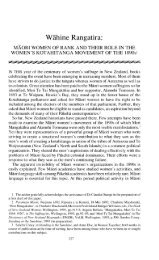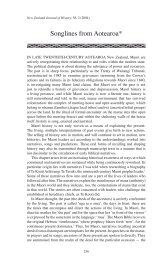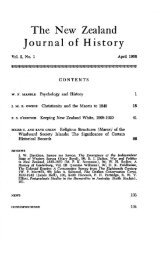Songlines from Aotearoa* - New Zealand Journal of History
Songlines from Aotearoa* - New Zealand Journal of History
Songlines from Aotearoa* - New Zealand Journal of History
Create successful ePaper yourself
Turn your PDF publications into a flip-book with our unique Google optimized e-Paper software.
SONGLINES FROM AOTEAROA 259<br />
<strong>of</strong> the small brown lizard (papateretere), with his back arched and his fingers<br />
splayed: 11 the lizard is the sign <strong>of</strong> the person who belongs with the world <strong>of</strong> the<br />
spirits.<br />
Respectively Te Kooti, Hamiora and Ihaka told the story <strong>of</strong> themselves,<br />
establishing their direct link to Toiroa. In a similar fashion, indigenous leaders<br />
<strong>of</strong> the northern Andes, <strong>from</strong> the late seventeenth century to the 1980s, narrated<br />
events that established themselves and their legitimacy through their ‘descent’<br />
<strong>from</strong> earlier culture heroes. Don Juan Tama de Estrella <strong>of</strong> Páez, as an old man<br />
in 1708, narrated an account <strong>of</strong> the defeat and exile <strong>of</strong> neighbouring people<br />
as his own deeds (events that had occurred at least 75 years before he was<br />
born). Juan Tama is a mythic hero in twentieth-century Páez oral and written<br />
narratives, and is believed to inhabit the lake that now bears his name, appearing<br />
at times <strong>of</strong> great danger, such as La Violencia in the 1950s, to aid his people.<br />
He was born at a time when the Morning Star, Venus, was at its brightest and<br />
was, he said, ‘the son <strong>of</strong> the star <strong>of</strong> the Tama Stream’, that is, the local river<br />
into which little ‘stars’ fall when the water runs quickly at the June solstice. 12<br />
Thus, Estrella (Star) is the name he assumed in his own lifetime. Not only did<br />
Juan Tama telescope history in his narratives; he also projected his mythic<br />
image into the future, creating himself as divine emissary for his people. In<br />
the twentieth century, the activist leader <strong>of</strong> Páez, Manuel Qintín Lame, in turn,<br />
considered himself as the bearer <strong>of</strong> the inheritance <strong>of</strong> Juan Tama.<br />
Te Kooti Arikirangi and those who claimed to be his successor deployed<br />
history similarly. There were ancestral tasks and quests, which Te Kooti set<br />
and which his narratives revive; there were, and are, new tasks and quests<br />
that the later narrators set for future generations. The Tuhoe prophet Rua<br />
Kenana Hepetipa claimed his baptismal name Hepetipa (Hephzibah) in 1906<br />
<strong>from</strong> a prediction <strong>of</strong> Te Kooti’s uttered in 1885: ‘Te kupu whakaari mo te<br />
maungarongo . . . e ki nei ka karangatia koe ko Hepetipa, to whenua ko Peura,<br />
no te mea ka hua reka a lhoa i a koe, a ka whai tahu to whenua/The prophetic<br />
saying concerning the abiding peace . . . it says you shall be called Hephzibah<br />
and your land Beulah, for the Lord is well pleased with you, and your land<br />
shall have a spouse.’ 13 The scriptural text upon which this predictive message<br />
had been based was Isaiah 62:4, which looks to restoration <strong>of</strong> fruitfulness in<br />
the land. Rua was baptized as Hepetipa by Eria Raukura (Tutara-kauika), the<br />
senior tohunga <strong>of</strong> the Ringatu faith, which Te Kooti developed in exile. Eria<br />
baptized Rua in the flowing waters <strong>of</strong> the Waipaoa River, which courses down<br />
<strong>from</strong> the mountains into Poverty Bay, Te Kooti’s tribal area, to which he was<br />
never able to return. In taking this name Rua was stating that he was indeed<br />
the daughter <strong>of</strong> Zion. 14 The quests Rua undertook as prophet stem variously<br />
<strong>from</strong> tasks set by Te Kooti for his successor, <strong>from</strong> Rua’s own interpretations <strong>of</strong><br />
Tuhoe history, and <strong>from</strong> contemporary political events.<br />
As the aspirant but divisive leader <strong>of</strong> Tuhoe, the mountain people <strong>of</strong> the<br />
Urewera, Rua had to undertake encounters with the taniwha, the monsterguardians<br />
<strong>of</strong> their lands. In 1909, on a much photographed boating expedition<br />
on Waikaremoana, Tuhoe’s wild and beautiful lake, Rua ‘pacified’ Haumapuhia,<br />
the lake’s turbulent protector. According to traditional accounts, Haumapuhia<br />
was betrayed by her father and drowned there; her struggles to free herself



